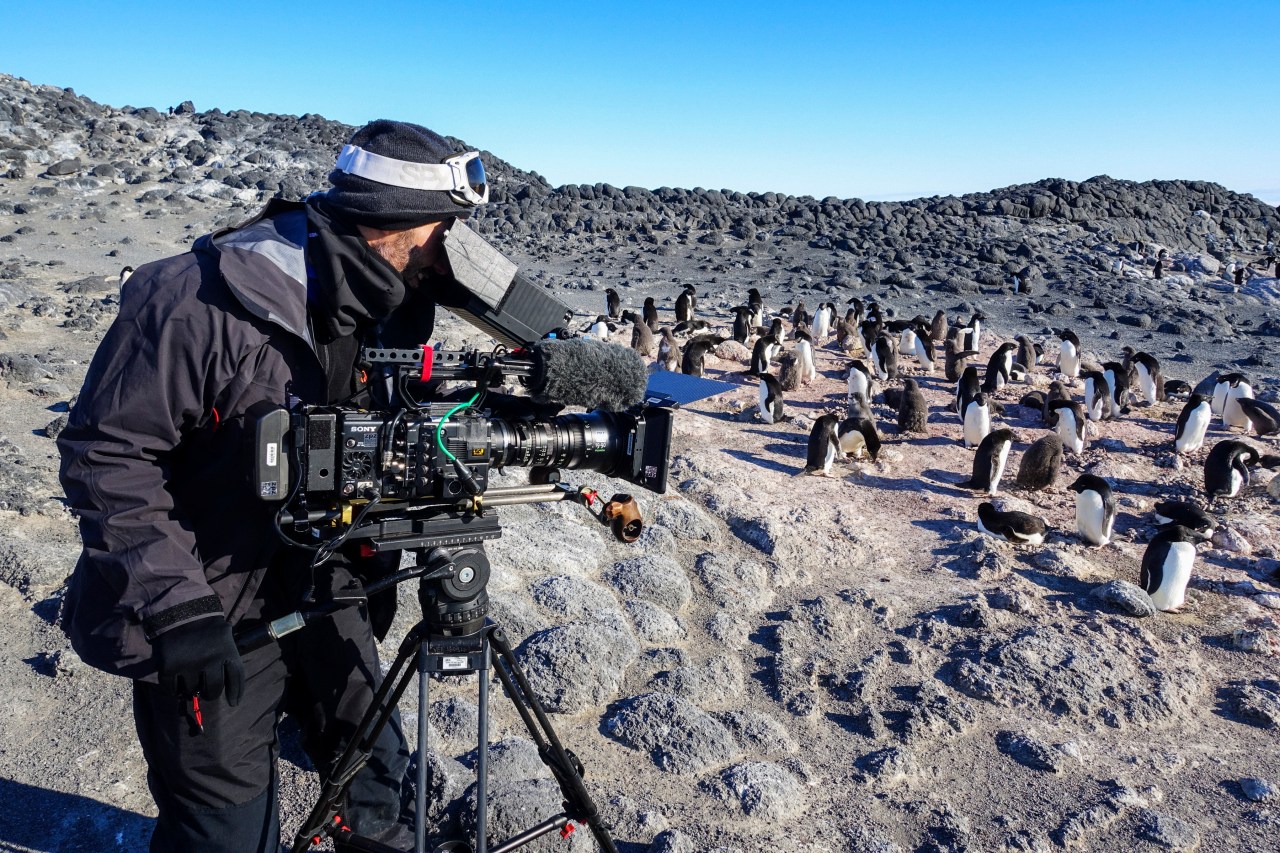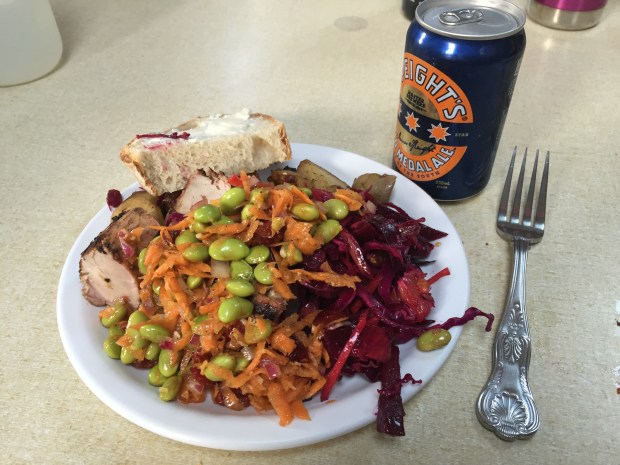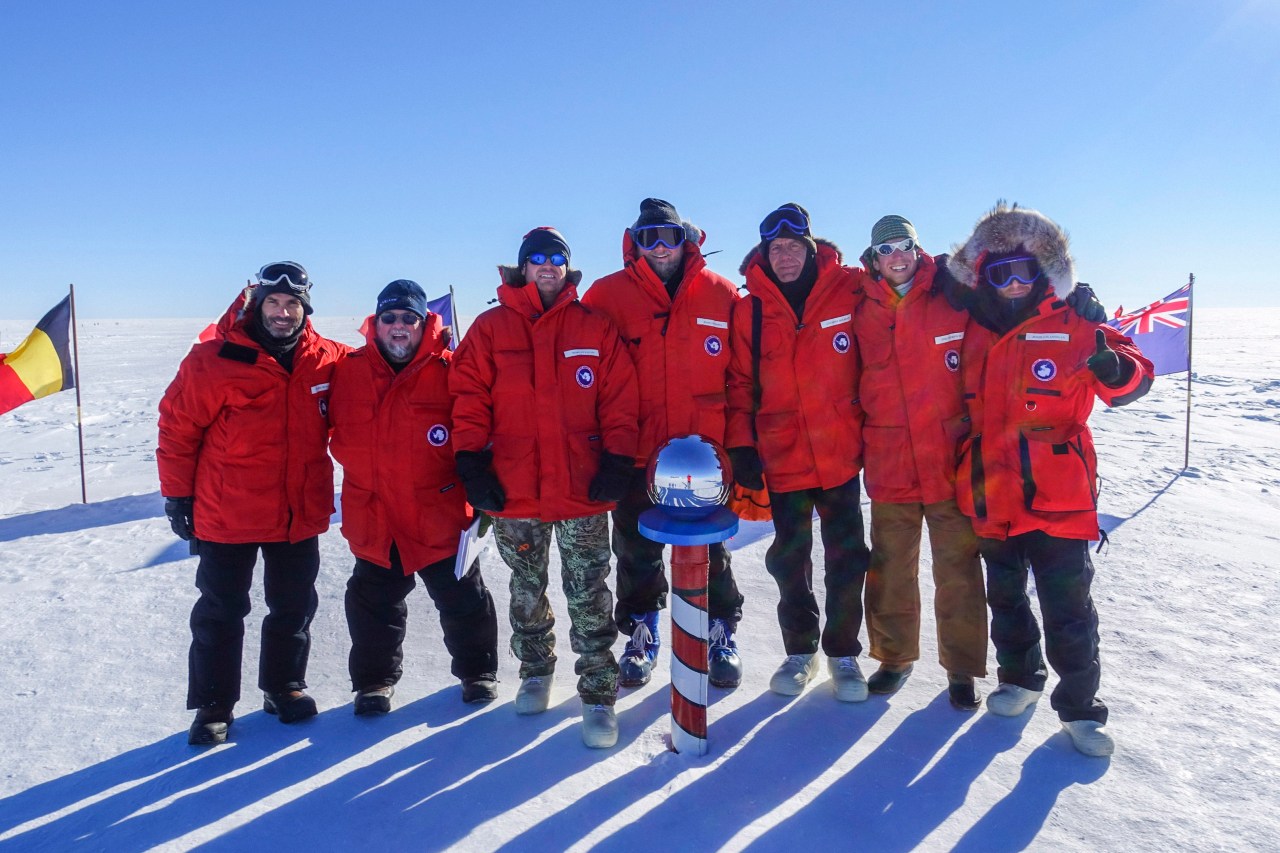From keeping your gear to your fingers from freezing, Antarctica is one of the most difficult places on Earth for a film crew to work. Helen Cho, director of special operations and producer at Zero Point Zero Production, sat down with the Antarctica episode crew to talk about what it was like filming and living at the bottom of the world. Erik Osterholm, Director, Josh Ferrell, Producer, Morgan Fallon, Director of Photography, Frederic Menou, Director of Photography, and Michael Ruffino, Original Music, tell the stories behind one of Parts Unknown’s most daring episodes.
This interview has been edited and condensed.
Helen Cho: How did the idea for an Antarctica episode come about?
Erik Osterholm: I had always been fascinated by Antarctica. It’s that giant white space at the bottom of the map that your eyes always drifted towards. My first trips down to the continent were on sailboats crossing the infamous Drake Passage for various documentary film projects. Once I finally got there I was blown away by the landscape, wildlife, and rawness of it all. It was also on those trips that I started to meet the unique individuals who had also been hooked by this other world at the bottom of our planet. Once I started working on “Parts Unknown” I knew it was a place that the show and Tony had to experience. We worked with the NSF [National Science Foundation] for almost two years to make it happen.
Cho: How was prep different for this shoot than for others?
Osterholm: For an episode like this it’s not just about the creative. It’s also about keeping your crew and yourself safe and prepared for what is a very harsh and unpredictable environment. It’s also the type of place where you have very, very, very little control—over weather, logistics, timing. The phrase “It’s a harsh continent” is a well-worn but very true expression. Basically, preparing for this show was preparing for unpredictability— being set up, as a team, to be able to pivot with whatever obstacle or opportunity presented itself. It’s very different than how we work in much of the rest of the world.
Josh Ferrell: We went through extensive physicals. If you had a heart condition and you’re down there, you’re stuck until they could fly you out, and that’s a risk they can’t take. Working with the NSF was incredible. They were an amazing resource. It was basically, “So who all is cool? Who all is interesting?” and they gave us a giant list. They gave us a flood of all these people, so Erik and I probably made two to three months’ worth of phone calls just getting to know everybody.
Morgan Fallon: It’s the biggest kit we’ve ever brought on any show. We had multiple layers of redundancies on everything we brought because you’re in a difficult environment, so there’s a high likelihood of something failing at some point along the way. And just the expense of flying a C-130 Hercules seven hours from Christchurch, New Zealand, to McMurdo Station—there’s no way to get an emergency bailout or anything like that. A lot of weatherproofing as well. The LCD screens we use are particularly susceptible to the cold, so we built insulated Mylar pouches for the LCDs that we would put hand warmers in. So those worked really well when we were in the [ice shelf] tunnels and it was negative 60, negative 70. We were really well prepared. We’d have hand warmers inside the battery bags, and then we’d keep those warm inside [insulated] bags.

Cho: It was daylight all the time, right? What was that like?
Ferrell: Have you ever seen “Insomnia”? Great images of Al Pacino fighting with curtains. It f**ks with you. It was crazy ’cause we technically landed at like 9 at night and it looked like 11 a.m. We spent a solid 12 hours at the South Pole and the sun stayed up there. We took a photo there, and it looks like it’s 1 p.m. and it’s really like 11 at night. I think it made the trip even more surreal than it was. I mean, going to Antarctica was pretty surreal, and then on top of that, it was like daylight 24/7.
Fallon: The problem is that most of the day the light really sucks. It’s the crappy midday light that we prefer not to shoot in. So Erik and I would wake up at 3 a.m. and shoot the magic hours between 2 in the morning and 4 in the morning when the sun is at the lowest point in its ellipses. Some of my favorite shots in the show are shot during that very early part of the day.
Osterholm: Cold, constant sun, lack of sleep from constant daylight, complete and total unpredictability around weather, logistics, and planning. But all of those challenges bring out the best in people. It’s part of what makes Antarctica special. You have to be comfortable with the uncomfortable—I love that. The crew was awesome, and the contractors and scientists we met were incredible: a special breed of individuals that don’t shy away from the challenges that exist down there.
Cho: What films and music did you guys look at as references? And Mike, what was your approach to scoring this episode?
Ferrell: “The Thing.” That’s a John Carpenter special right there, but there was something so eerie— But that was basically just Antarctica. Werner Herzog’s “Encounters at the End of the World” was also required viewing.
Fallon: John Carpenter films. Getting the kind of creepiness and cerebral nature of being in that environment. It’s such a stark environment and it’s all sunshine, but there is something inherently creepy about it. I think there’s very much a palpable sense of danger and history of people getting in deep shit down there. It’s a menacing landscape in that way, and it hit the Carpenter stuff less in terms of cinematography and more in terms of tone.
Michael Ruffino: Yes, “The Thing” and “Apocalypse Now.” For music, referenced Bob Wills & His Texas Playboys, Vangelis, The Chambers Brothers, John Lee Hooker, Dick Dale, Raging Slab, Blackfoot, John Cage, and 19th-century American folk music. Field sound recorded during the shoot—snow, ice, machinery—was the starting point for some music—manipulated to be played like instruments, combined with regular instruments—and is variously mixed into final tracks.
Cho: Where did the crew and Tony stay?
Ferrell: We stayed at McMurdo Station, and it’s really interesting because it was originally a Navy base, so it’s really like dorm life. Everyone has a roommate unless you’re a VIP. Tony’s a VIP, but I went to a California State University and his room was identical to my dorm room. Now the crew, we stayed in the same building as the galley, which was really cool. Communal bathrooms, roommates.
Cho: What were crew meals like? What was your favorite or most memorable crew meal there?
Ferrell: We ate at the galley a lot. They have a to-go station, and there’s prewrapped sandwiches that you’d just throw in your bag. We always had a solid supply of that, but mainly we ate in the galley. And the galley is where Tony caught me eating pizza with ranch dressing, which I will not hear the end of. By far the best was Ray’s meal at Lake Hoare. Ray does the best she can with what she has. The pork loin they had was from 2012, and she has a giant vault worth of spices. It was something special—it was a fantastic meal.
Fallon: We spent a day in a helicopter with a very cool pilot—ex-military guy who had been flying Apaches and Cobras in Afghanistan—and he just took us on an ultimate dream tour of one of the rarest and most secluded places on Earth. I was with Erik and Fred, and we had this helicopter to ourselves, all day, and flew from peak to peak filming the most dramatic landscapes you could imagine: twenty-five-hundred-foot sheer cliffs that we’d land on that opened up to valleys that would swallow Manhattan. We were doing that all day in the cold, and as we were going back towards McMurdo Station, we had to cross this big glacier and then land at this refueling station. We get to this refueling station, and the people who run the refueling station gave us hot coffee and pulled-pork sandwiches. It was some of the best pulled pork I’ve ever had, and we’re sorta just standing there in the freezing cold and the wind with the most gracious, friendly, and gregarious people you could imagine—the three people who live at the refueling station. We’re literally eating the meal over 55-gallon drums of jet fuel. And it’s absolutely magical and will go down as one of my favorite meals I’ve ever had in my life, because the combination of elements—the cold, the environment, where we were, the people—one of those magic “Parts Unknown” things where all those elements come together to make the meal— I’ll never forget that.

Cho: What was the stylistic approach to shooting in Antarctica?
Fallon: Erik and I really wanted to look at the continent from the point of view of the scientist and get into the subjective experience of being a scientist and going down there. So you start with macros, start with huge, wide shots of someone just getting off the plane, right, and being like, “Oh my god it’s almost too big to understand,” these gigantic, wide shots. And as you get into your work as a scientist, you begin to focus smaller and smaller, down to the nano level. We wanted a show that was [focused on] the macro and the micro. The microscopic level of Antarctica is part of the landscape. It’s part of the environment. We did a lot of that style of shooting, and you see that in the show in little ice formations and even down to the point where they got stock footage of microscopic animals. It’s like Russian dolls, huge wide shots down to the very tiny, focused experience of the scientists.
We couldn’t try and compete with a nature doc. We had to think with a different point of view. We can’t go down there and spend six months just shooting penguins. We had three hours to shoot penguins. The Osmos [cameras] can very quickly go into places other cameras can’t go, but they’re still smooth and steady, so you’re still floating through the penguins at penguin level. The other thing those were really great for was we would be shooting in cockpits a lot and you can control the Osmos by Bluetooth with iPads. So we got two iPads and fixed the Osmos on the front of the helicopter, where no other camera would sit, but we’d still be able to pan and tilt and look at what Tony and the pilot were looking at and pan back to Tony. So it adds movement. Those are really very useful tools to being able to quickly shoot all the various cockpits and modes of conveyance that we had to do very quickly. You just land and jump on a plane to the South Pole. There’s no time to be like, “Oh, we’re gonna rig a C-130 now.” All the aerials in the show were all shot on those Osmos. And you’re getting something close to the level of production value that you’d get from a shooter from a very expensive helicopter mount, but it’s really just me with an Osmo, sticking my hand out the window of the helicopter.
Cho: In retrospect, was there anything you wished you could capture that you didn’t or weren’t able to?
Fallon: There are things you can’t capture there. I would say it’s more of a sense or a feeling that you only get if you’re lucky enough to end up there. I have never found such respect or awe for a landscape. I didn’t take a rock from there. I didn’t move a rock. It was like you get this sense that no one has touched where you are and no one should touch it. It was very humbling and almost a religious kind of experience being there. The brutality and isolation of the landscape— How you’d ever capture that on video I don’t know. It’s just a feeling.
And you’d start talking to the dishwasher and realize that they have a master’s degree in Italian literature and hitchhiked from China to Afghanistan. That’s the way with everything down there. Dishwashing is a way to get down to this extraordinary place that no one gets to go to. You couldn’t come up with a more talented group of people at McMurdo. You could build a civilization with the brainpower at McMurdo at any given time. People have such an incredibly high respect of that landscape, and nothing gets wasted, nothing gets thrown out. You will not find a piece of paper on the ground anywhere on that continent. That is not just because those are the rules. That’s because you go there and it’s very clear from the beginning that this is a place we haven’t screwed up and we shouldn’t screw up. That feeling is something you can’t exactly capture with the camera.

Cho: Are there any other moments that stand out?
Ferrell: One night we were out there on Lake Hoare—it’s a frozen lake—and we were filming on the ice because there were these beautiful ice structures on top of the water. I was out there with Fred and Josh Flannigan, and we were on the ice and we heard this “crack crack crack” and we all fell in. It was only 4 inches of water, but we were all freaked out. This was at like 1 in the morning, felt like 2 in the afternoon. It was a good, hearty laugh, and we pulled each other up and tried not to stand next to each other after that because we didn’t want the ice to crack any more. And it was great because you can hear one of the researchers yell from a distance, “That means she likes you!” It was just so cool.
Fallon: Josh Ferrell and I played an impromptu gig at the music room. I was playing drums. Josh was singing and playing guitar. We played this gig, then we went to the commissary and ate 700 pizzas. Then we were walking by what they call the “arts and crafts room,” and there’s three nerdy goth kids in there who go like, “Hey, do you want to do arts and crafts with us?” And we’re like, “Yeah, sure.” It’s 1 in the morning and we go in there and we’re like, “So what are we doing?” And they’re like, “Well, we’re building stuff out of space junk.” And I ask, “What do you mean, ‘space junk?’” And there’s all of this stuff there. It’s a bunch of brass, locks, and door hinges and stuff. They say it was all sent into space on a weather balloon, and now they’re building space-junk arts and crafts to bring home to people. It was a perfect McMurdo experience—the most ordinary objects on Earth but they’ve been to space and all of a sudden they’re cool, and you’re sitting in this arts and crafts room at 1:30 in the morning and the sun blindingly coming in the window and having just played a jam session in the music room. It’s where the ordinary becomes extraordinary. That’s a McMurdo thing. Every person you talk to, the story unfolds bigger than you could ever expect. Every interaction and everything you do there, there’s something so much bigger and deeper behind it. The place is kind of magical.